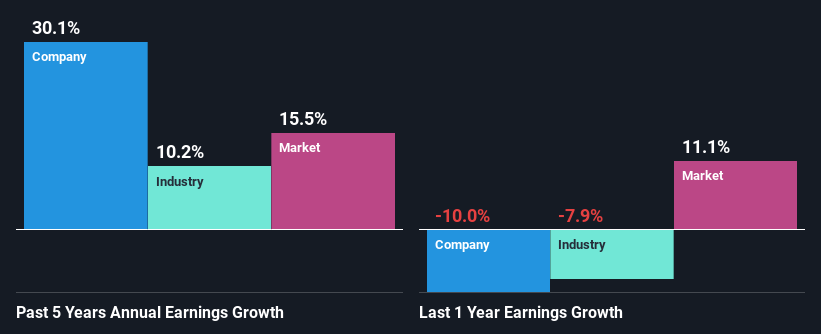Is Capitol Health Limited's (ASX:CAJ) Recent Stock Performance Influenced By Its Financials In Any Way?
Capitol Health's (ASX:CAJ) stock is up by 4.9% over the past three months. As most would know, long-term fundamentals have a strong correlation with market price movements, so we decided to look at the company's key financial indicators today to determine if they have any role to play in the recent price movement. Specifically, we decided to study Capitol Health's ROE in this article.
Return on equity or ROE is a key measure used to assess how efficiently a company's management is utilizing the company's capital. In short, ROE shows the profit each dollar generates with respect to its shareholder investments.
See our latest analysis for Capitol Health
How Do You Calculate Return On Equity?
The formula for return on equity is:
Return on Equity = Net Profit (from continuing operations) ÷ Shareholders' Equity
So, based on the above formula, the ROE for Capitol Health is:
7.1% = AU$11m ÷ AU$154m (Based on the trailing twelve months to June 2022).
The 'return' is the amount earned after tax over the last twelve months. That means that for every A$1 worth of shareholders' equity, the company generated A$0.07 in profit.
What Has ROE Got To Do With Earnings Growth?
Thus far, we have learned that ROE measures how efficiently a company is generating its profits. Based on how much of its profits the company chooses to reinvest or "retain", we are then able to evaluate a company's future ability to generate profits. Assuming all else is equal, companies that have both a higher return on equity and higher profit retention are usually the ones that have a higher growth rate when compared to companies that don't have the same features.
Capitol Health's Earnings Growth And 7.1% ROE
When you first look at it, Capitol Health's ROE doesn't look that attractive. However, its ROE is similar to the industry average of 7.2%, so we won't completely dismiss the company. Moreover, we are quite pleased to see that Capitol Health's net income grew significantly at a rate of 30% over the last five years. Taking into consideration that the ROE is not particularly high, we reckon that there could also be other factors at play which could be influencing the company's growth. For instance, the company has a low payout ratio or is being managed efficiently.
As a next step, we compared Capitol Health's net income growth with the industry, and pleasingly, we found that the growth seen by the company is higher than the average industry growth of 10%.
The basis for attaching value to a company is, to a great extent, tied to its earnings growth. What investors need to determine next is if the expected earnings growth, or the lack of it, is already built into the share price. By doing so, they will have an idea if the stock is headed into clear blue waters or if swampy waters await. What is CAJ worth today? The intrinsic value infographic in our free research report helps visualize whether CAJ is currently mispriced by the market.
Is Capitol Health Using Its Retained Earnings Effectively?
The high three-year median payout ratio of 86% (implying that it keeps only 14% of profits) for Capitol Health suggests that the company's growth wasn't really hampered despite it returning most of the earnings to its shareholders.
Moreover, Capitol Health is determined to keep sharing its profits with shareholders which we infer from its long history of paying a dividend for at least ten years. Upon studying the latest analysts' consensus data, we found that the company is expected to keep paying out approximately 69% of its profits over the next three years. Still, forecasts suggest that Capitol Health's future ROE will rise to 11% even though the the company's payout ratio is not expected to change by much.
Summary
On the whole, we do feel that Capitol Health has some positive attributes. While no doubt its earnings growth is pretty substantial, we do feel that the reinvestment rate is pretty low, meaning, the earnings growth number could have been significantly higher had the company been retaining more of its profits. Having said that, the company's earnings growth is expected to slow down, as forecasted in the current analyst estimates. To know more about the latest analysts predictions for the company, check out this visualization of analyst forecasts for the company.
Have feedback on this article? Concerned about the content? Get in touch with us directly. Alternatively, email editorial-team (at) simplywallst.com.
This article by Simply Wall St is general in nature. We provide commentary based on historical data and analyst forecasts only using an unbiased methodology and our articles are not intended to be financial advice. It does not constitute a recommendation to buy or sell any stock, and does not take account of your objectives, or your financial situation. We aim to bring you long-term focused analysis driven by fundamental data. Note that our analysis may not factor in the latest price-sensitive company announcements or qualitative material. Simply Wall St has no position in any stocks mentioned.
Join A Paid User Research Session
You’ll receive a US$30 Amazon Gift card for 1 hour of your time while helping us build better investing tools for the individual investors like yourself. Sign up here

 Yahoo Finance
Yahoo Finance 
